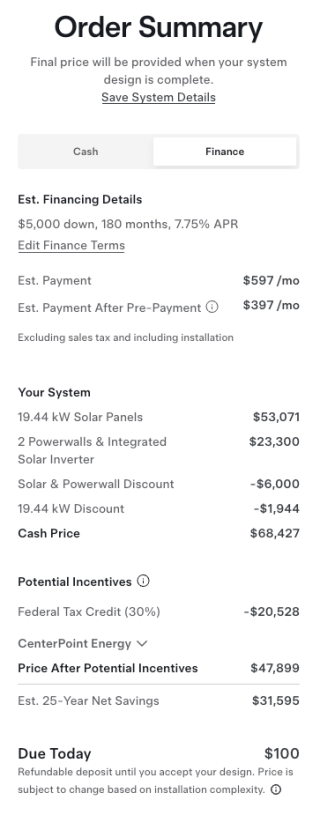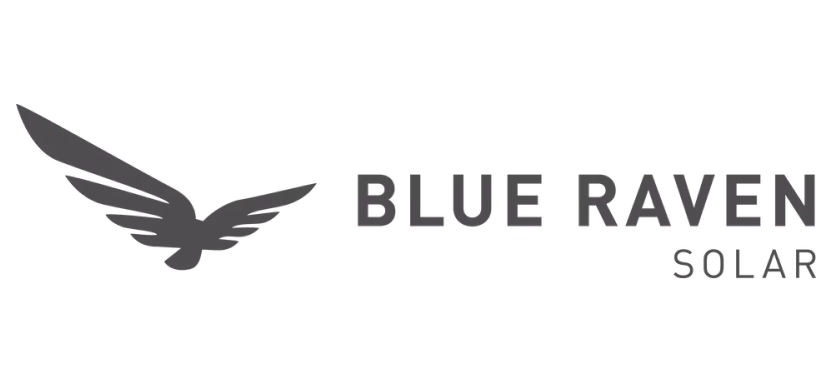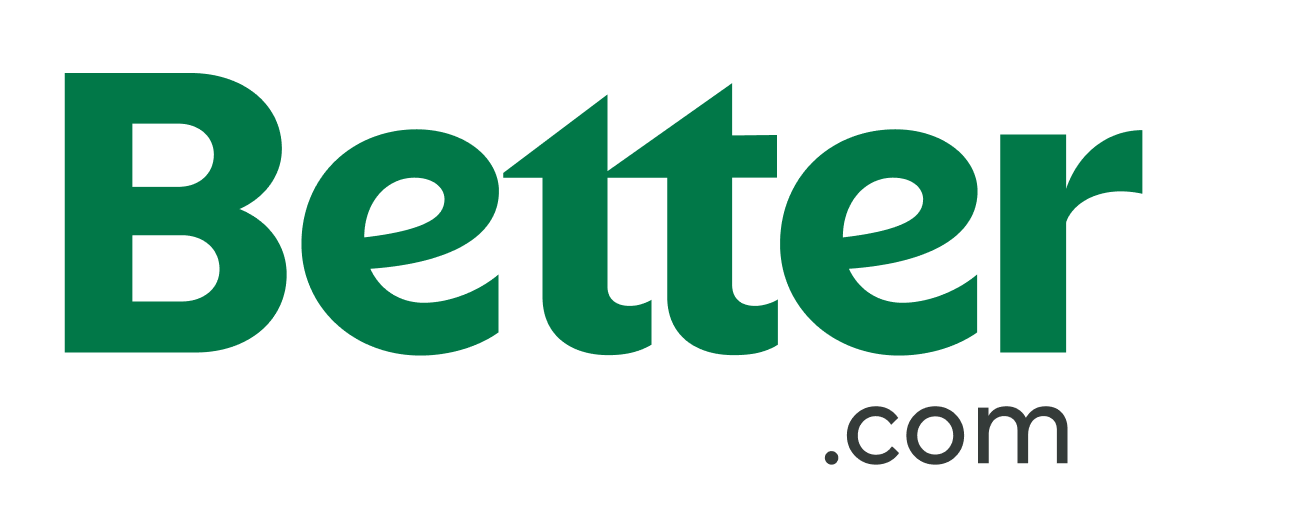on SolarEdge's website
Tesla Solar Review 2025: Costs and Options
Some or all of the mortgage lenders featured on our site are advertising partners of NerdWallet, but this does not influence our evaluations, lender star ratings or the order in which lenders are listed on the page. Our opinions are our own. Here is a list of our partners.
With its streamlined in-house system, Tesla is a contender for homeowners who want a comprehensive solution for solar power with energy storage to minimize dependence on their utility companies. However, customer reviews are on the lower end compared to some of its competitors.
Tesla probably brings to mind sleek electric vehicles, but it's proving itself in the residential solar power arena as well. The company moved into the market in 2016 when it acquired SolarCity, a solar array installer. It has since launched its own solar panels and solar roof (a system that replaces a traditional roof with solar tiles), along with its Powerwall battery for solar energy storage. The company lets customers design their own systems with a free quote without requiring personal information, and it shows the difference in costs with cash and financing options.
Our take on Tesla solar
Overall | 3.5 NerdWallet rating |
Pricing transparency | 5.0 NerdWallet rating |
Workmanship warranty | 1.0 NerdWallet rating |
Product/equipment warranty | 4.0 NerdWallet rating |
Performance guarantee | 3.0 NerdWallet rating |
Customer satisfaction | 3.0 NerdWallet rating |
This snapshot shows some factors that we consider when rating a solar company and is not representative of the full evaluation process. | |
What we like about Tesla solar
Easy to get a solar panel system quote. You don’t have to give the company your information for a quote; you can select system specifications to see an estimate of total cost along with price differences among payment methods.
Manufactures its own panels. Tesla makes and sells its own solar panels and solar roof tiles, so it knows its systems inside and out.
Pairs well with its Powerwall battery. Tesla's solar panels work with Tesla’s Powerwall battery so homeowners who want to store energy to use later can do so.
What we don’t like about Tesla solar
Uses third-party installers in some areas. Tesla hires third-party installers instead of its own employees to install solar systems.
Can’t transfer Tesla loans to new homeowners. If you get a loan from Tesla to buy your solar panels, you have to pay off your loan if you sell your house.
Can’t see a solar roof quote without talking with a salesperson. You can get a quote for solar panels online, but if you want to learn about solar roof pricing, you’ll have to get on the phone with a representative.
Solar roof warranty doesn’t repair your home. If the installation of a solar roof (not solar panels) causes your roof to leak and damages your home as a result, the warranty won’t pay to repair the house. It only covers the defective equipment.
Tesla’s solar products
Solar panels
Tesla’s newest solar panel models can provide up to 405 watts of power and pair with the company’s inverter, which converts up to 7.6 kW of power. They’re not the most sophisticated panels on the market, but they offer good energy production.
Tesla can install solar panels on the following roof types:
Asphalt or composition shingles (3-tab, dimensional and architectural).
Concrete tile.
Flat roof if allowed by local building codes.
» MORE: What is solar panel efficiency?
Solar roof
Tesla’s solar roof replaces your existing roof with a combination of energy-producing and metal tiles. The energy-producing tiles act as miniature solar panels, and the steel tiles help with the longevity of the roof. The solar roof tiles can produce up to 72 watts per tile and have the highest available industry ratings against hail, wind and fire. Designs include vent covers, ridge caps and flashing for a complete roof.
Tesla can install a solar roof to replace the following types of existing roofs:
Asphalt or composition shingles (3-tab, dimensional and architectural).
Concrete tile.
Metal.
Clay tile.
Slate.
Wood shake.
Tesla removes guttering before installing solar roofs, but it won’t reinstall them. You'll have to find someone else to reinstall your guttering. Also, you can't use copper gutters with a Tesla solar roof.
Solar batteries
A Tesla Powerwall battery stores your excess solar power for use when the solar panels aren’t producing energy, such as at night or during power outages. You can pull energy from your utility company to recharge it. All three Powerwall models can store up to 13.5 kW of power, with the Powerwall 3 providing up to 11.5 kW of continuous power.
The company provides warranty repairs. Although Tesla doesn’t publish the time frame in which technicians generally respond to service requests, it claims that customers are scheduled with the earliest available appointment in their area, which is based on technician availability.
How much does Tesla solar cost?
As with most solar power systems, the total price for solar panels and installation depends on the equipment and installer that you choose. Homeowners who purchase their systems may qualify for tax incentives, which lowers the overall cost.
Tesla doesn’t publish pricing for its solar roof, and the only way customers can get a quote for it is to talk to a sales representative. We asked Tesla for a starting price for solar roof installations, but the company chose not to provide one.
To give a range of prices for Tesla’s solar panel arrays, we requested several quotes for different sizes of systems with and without the Powerwall battery for energy storage.
kW | Without Powerwall | With one Powerwall |
|---|---|---|
4.451 kW. | $12,312. | $22,712. |
9.02 kW. | $23,723. | $34,123. |
13.12 kW. | $34,506. | $44,906. |
These quotes were collected in January 2025 and use the kW Tesla recommended to provide the estimated energy usage we indicated for the quote. Some quotes included a discount that was automatically applied when customers place an order; it might not be available on future orders. Some homes require more than one Powerwall in order to store enough energy to power the home without supplementing with electricity from a utility provider. This may increase the total cost. | ||
Tesla’s payment options
Customers can pay for their Tesla solar power systems with cash or with a loan. If you want to pay cash, you’ll have to pay during the inspection stage. Tesla offers in-house financing, but you could also get a loan from your bank or a different lender instead. Customers who get a Tesla loan and have excellent credit might qualify for a loan without a down payment.
A downside to borrowing through Tesla is that it doesn’t let you transfer your loan to the new homeowner. This means the new homeowner will have warranty coverage after purchasing the home, but you’ll need to pay off your loan when you sell the house. This can be an issue for certain homeowners.
“If you don't have the cash reserves to cover the remainder of the Tesla loan yourself, you'll have to pull it from the proceeds from the sale of your house,” says Taylor Getler, a NerdWallet expert on home ownership. “If your home hasn't grown enough in value to cover both your remaining mortgage balance and your Tesla loan, then you'll likely have to take out an additional loan to make up the difference. This could complicate your next home purchase — you'd have less cash to bring to the table as a down payment, and this new loan means you'll have a higher debt-to-income ratio (an important consideration for lenders when deciding how much you can borrow).”
However, if you sell your house, you can transfer your service agreement and warranty to the new homeowner.
Tesla offers financing for installations in Washington, D.C. and 27 states: Arizona, California, Colorado, Connecticut, Delaware, Florida, Georgia, Hawaii, Illinois, Massachusetts, Maryland, North Carolina, New Hampshire, New Jersey, New Mexico, Nevada, New York, Oregon, Pennsylvania, Rhode Island, South Carolina, Texas, Utah, Virginia, Vermont, Washington and Wisconsin.
Ordering a Tesla system
Although you can call Tesla to order a solar power system, the company encourages customers to order through its website. Here's how to get an estimate with Tesla's website quote widget.
To get a quote for a solar roof, you’ll have to enter your contact information and talk with a certified installer; the website won’t give you a quote for solar roofs.
To start a solar panel order, you’ll enter your address and an estimate of your average monthly energy bill. Tesla uses this information to estimate the square footage of your roof (this is customizable) and the size of the system you need.
Once you’ve confirmed your roof’s square footage, you’ll choose whether you want a Powerwall battery, solar panels plus a Powerwall or a solar roof plus a Powerwall. (You can remove the Powerwall battery later on if you just want a quote for panels.)
Tesla gives you two quotes: one for a system that produces enough energy to power your house based on your current usage, and another for a larger system to meet what Tesla calls your future needs. It isn’t clear how Tesla calculates future usage. The system also lets you enter a custom size if neither of the automatic quotes fit what you need. You can see the prices with or without possible tax incentives.
You can customize the number of Powerwall batteries you want (zero to 10). The more Powerwall batteries you add, the larger the discount you’ll get. If you buy three or more Powerwall batteries, you might qualify for a discount.
Click “Continue to Order Summary” to see your quote.
The pricing comparison screen lets you see the difference in cost if you pay in cash versus financing the purchase.
If you view the option to finance the purchase, you can customize your down payment and the term of the loan. These inputs change the total cost of the system. Keep in mind that the quote estimates the annual percentage rate, which might vary depending on your credit score. It also doesn’t include sales tax.
If you want to proceed, you can pay the deposit to start the process. When we tested the Tesla ordering widget, our order summary said we only had to pay $100 to start the process for a $61,510 system.

An example of an order summary through Tesla's quoting widget on the company's website
Tesla’s installation process
Tesla’s installation process is similar to what most solar companies do, but it relies on virtual steps more than most competitors. An installation for Tesla solar panels or solar roof usually includes:
Online order. The customer enters certain information on Tesla’s website and chooses the system design to place the order.
Home assessment. The company uses satellite imaging and an onsite visit to create a system design.
Customer preferences. If desired, the customer can modify the design online.
Design approval. The customer approves the final design.
Permitting. Tesla files all relevant permits with the customer’s city and utility company.
Installation. The company says that most installations are finished within a day, but larger systems can take longer.
Inspection. Tesla arranges required inspections and approvals.
Activation. The company lets you know when it’s time to turn on your system.
Tesla uses third-party installers in some areas. These companies complete additional training on Tesla product and installation processes.
Tesla’s warranties
Tesla’s solar power systems include a 10-year comprehensive warranty, which covers labor for repairing issues related to a system’s Powerwall, solar inverter, roof mounting and leaks. This coverage is in addition to product-specific warranties.
These things aren’t covered, though:
Issues caused by a certified installer or related to certain equipment a certified installer provides.
Certain products if they are located within a certain distance from salt water, salt spray or salt fog.
If you use a certified Tesla installer, your contract and installation warranty are with the third-party installer, not Tesla.
Solar panels
Tesla warranties its solar panels’ materials and performance for 25 years. The company guarantees that its panels will produce at least 98% of its stated power during the first year and that the production won’t decline more than 0.54% each year afterward through the end of the warranty.
» MORE: How long do solar panels last?
Solar roof
Tesla’s solar roof comes with a 25-year warranty that protects against manufacturing defects. If your roof fails within this warranty period, the company will repair or replace the parts or compensate you for the defective equipment. If it chooses to replace the part, it might use refurbished parts.
The solar roof warranty also guarantees that your solar roof will create at least 95% of its stated energy production within the first five years and won’t decline more than 0.5% in production each year after during the warranty period.
Tesla also warranties the solar roof against wind or rain penetrating your roof and damaging your house for 25 years. However, there are a few exceptions that are good to know ahead of time. The warranty:
Doesn’t cover damage to your house. If the roof doesn’t hold up to wind and rain, the warranty covers the repair or replacement of only the section of solar roof causing the leak. It won’t pay to repair any damage done to your house as a result of the leak.
Reduces coverage based on the roof’s age. Any issues with wind or rain after the first 10 years of the warranty are covered differently. Starting in the eleventh year, Tesla only pays for 60% of the material costs to repair or replace leaking sections of the solar roof (no labor or installation). The amount it covers decreases by 4% every year after that until the warranty expires.
Doesn’t cover damage caused by winds stronger than 139 miles per hour. If your solar roof is damaged by winds exceeding this limit, the warranty won’t cover repairs. Keep in mind that 139 miles per hour is the strength of a category 4 hurricane, so we’re talking high winds.
Powerwall batteries
Tesla warranties Powerwall+, Powerwall 2 and Powerwall 3 models against defects for 10 years. It also guarantees that Powerwall batteries will retain at least 70% of their initial 13.5 kWh storage capacity at the end of 10 years. The warranty doesn’t pay labor costs for covered replacement parts.
Solar inverter and shutdown device
Tesla inverters can come with a safety shutdown device. The company warranties its solar inverters for 12 ½ years and its shutdown devices for 25 years.
Tesla availability
Tesla solar equipment is available in all 50 states and Washington, D.C.
Customer reviews and experiences
NerdWallet considered customer reviews from three review websites to get a wider perspective of customer experiences. We’ve highlighted the types of experiences that we’ve found to be most common, keeping in mind that online reviews tend to lean toward negative experiences.
SolarReviews.com: 2.61 out of 5.
ConsumerAffairs: 1.8 out of 5.
Better Business Bureau: 5 out of 5.
What customers like about Tesla
Many happy customers say the installation teams are professional and efficient and respect customers’ properties. Others highlight Tesla’s price as one of the main reasons they went with their systems and feel that the overall cost was fair. Many customers also note that their systems perform well and produce enough energy to save money.
What customers don’t like about Tesla
Many customers who give Tesla low scores describe issues with misinformation and poor communication from customer service representatives, saying it can be difficult to talk to someone who can help. Some customers also say they had long wait times for Tesla to get everything arranged for them to turn on their systems. They also mention issues with having panels uninstalled and reinstalled when new roofs are needed.
Alternatives
on SolarEdge's website
» MORE: Read our full review of Blue Raven Solar
on Palmetto Solar's website
» MORE: Read our full review of Palmetto Solar
on SolarEdge's website
» MORE: Read our full review of Freedom Solar
on SolarEdge's website
Can I get financing for a solar panel system?
In addition to tax incentives and rebates, there are options available. Many solar installers offer financing, but you may also be able to finance your solar investment through a home equity loan or home equity line of credit (HELOC). These options may have lower interest rates than financing with an installer, future opportunities for refinancing and possible tax benefits.
Home equity loans and HELOCs are ways to borrow against the value of your home, converting equity into cash. With a home equity loan, you receive a lump-sum payment and then pay it back at a fixed interest rate over an agreed period of time, typically from five to 30 years. HELOCs are more akin to a credit card, something you use as needed. You’ll usually have 10 years to draw from the line of credit, during which time you only have to pay interest, and after that you pay both the principal and interest. HELOC interest rates typically are variable, meaning your monthly payment could rise or fall over time. And with each of these options, you're using your home as collateral.
Another option is a solar loan. Many banks, credit unions and online lenders offer these to fund solar panels and installation, with amounts typically from $1,000 to $100,000, and annual percentage rates ranging from 6% to 36%. They function like a personal loan: you receive a lump sum and repay it in equal monthly installments over a set period, typically two to seven years. And unlike with home equity financing, there is no collateral required for a solar loan. This means your home or solar panels aren’t at risk if you miss payments, but you may have to pay late fees.
So, yes, you likely can get financing. If you go this route, compare interest rates, terms and fees with any financing package that a solar provider may offer you to ensure you get the best deal.
Methodology
NerdWallet's Home Services team evaluated solar panel companies across several factors, including responsiveness to service requests, customer satisfaction, pricing transparency, warranty coverage (for workmanship and equipment), performance guarantee and customer service options. Because costs can vary by location, it's best to get quotes from multiple companies before making a decision. Read more about how NerdWallet rates solar panel companies.









